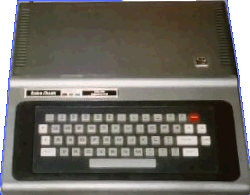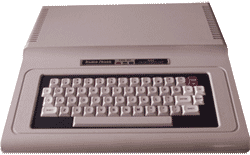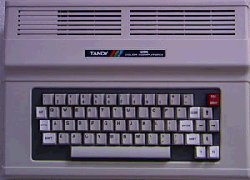Page Menu
- TRS-80 Color Computer: Coco 1
- TRS-80 Color Computer: Coco 2
- TRS-80 Color Computer: Coco 3
- TRS-80 Color Computer Emulators
- TRS-80 Color Computer Books
- TRS-80 Color Computer: MC-10
Color Computer I
Features

Click to Enlarge

Click to Enlarge
- Introduced on July 31st, 1980 for $399.00
- Motorola MC6809E 8-bit CPU running at .89MHz
- 4K RAM
- 8K ROM – Microsoft Color Basic v1.0
- 53 Key Keyboard
- 32 Column Display Ability (32 x 16 with 4 Colors / 256 x 192 with 2 Colors / 128 x 96 at 8 Colors / 128 x 192 with 4 Colors)
- 8 Colors (selectable from 2 preset 4 color palettes)
- RGB Modulator (to connect to color TV)
- RS-232 Interface (Serial Port)
- 1500 Baud Cassette Interface
- Two (2) Joystick Connectors
- Optional: ROM-PAK Cartrdige (Chess, Checkers, Quasar Commander, Personal Finance, CoCo Diagnostics)
- Optional (12/1980): 16K RAM Upgrade
- Optional: 32K RAM Upgrade
- Optional: 64K RAM Upgrade
- Optional (12/1980): 16K RAM Upgrade
- Optional (07/1981): Extended Color Basic Upgrade
Color Computer 2
Features

Click to Enlarge
- Same as the Color Computer I except
- 16-64K RAM
- 8K BASIC ROM or 16K EXTENDED BASIC ROM
- Smaller Case
- 53 Key QWERTY Keyboard (First COCO appearance of a BREAK Key)
- Lowercase Letters
- 6-Bit DAC (Digital-to-Analog Converter), allowing for 64 different volume levels
- Could be POKEd to 1.78Mhz, which had been enabled to allow for DMA access by external peripherals. The CPU was halted during these periods, as it could not handle this speed and would overheat if not halted.
- OS-9 Level II multi-tasking operating system
- Optional Equipment: MultiPak Interface
Color Computer 3
Features

Click to Enlarge
- Introduced on July 30th, 1986 for $219.95
- Motorola MC68b09 8-bit CPU running at 1.788MHz
- 128K RAM (Upgradable to 512K)
- 640 X 192 (BASIC) and 640 x 225 (Other)
- Colors: 4 at 640 x 192/225, 16 at 320 x 192, and 64 at 160 x 192.
- 80 Column Display Ability
- 4 analog inputs and 1 analog output
- Digital Input and Output
- OS-9 Level II multi-tasking operating system
- Optional Equipment: MultiPak Interface
- Optional Equipment: 5.25″ floppy drive
Emulators:
Please visit the Emulator page for up to date listings.
Books
(Kishore-M-Santwani).jpg) Title: 500 Pokes Peeks N’ Execs for the Color Computer
Title: 500 Pokes Peeks N’ Execs for the Color ComputerYear: 1986
Author: Kishore M Santwani
TOSEC: 500 Pokes Peeks N Execs for the TRS-80 Color Computer (1986)(Kishore M Santwani)
Size: 3,816,402
(Kishore-M-Santwani).jpg) Title: 500 Pokes Peeks N’ Execs for the Color Computer: Supplement
Title: 500 Pokes Peeks N’ Execs for the Color Computer: SupplementYear: 1986
Author: Kishore M Santwani
TOSEC: 500 Pokes Peeks N Execs for the TRS-80 Color Computer Supplement (1986)(Kishore M Santwani)
Size: 4,341,870
(Laurence-A-Tepolt).jpg) Title: Assembly Language Programming for the CoCo3
Title: Assembly Language Programming for the CoCo3Year: 1987
Author: Laurence A Tepolt
Publisher: Tepco
Pages: 70
TOSEC: Assembly Language Programming for the CoCo 3 (1987)(Laurence A Tepolt)
Size: 2,526,286
(Laurence-A-Tepolt).jpg) Title: Assembly Language Programming for the Color Computer
Title: Assembly Language Programming for the Color ComputerYear: 1985
Author: Laurence A Tepolt
Publisher: Tepco
Pages: 304
TOSEC: Assembly Language Programming for the Color Computer (1985)(Laurence A Tepolt)
Size: 14,038,806
(Spectral-Associates).jpg) Title: Color Basic Unravelled II
Title: Color Basic Unravelled IIYear: 1999
Publisher/Author: Spectral Associates
TOSEC: Color Basic Unravelled II (1999)(Spectral Associates)
Size: 707,674
(William-Barden-Jr).jpg) Title: Color Computer Assembly Language Programming
Title: Color Computer Assembly Language ProgrammingYear: 1983
Publisher/Author: William Barden Jr
TOSEC: Color Computer Assembly Language Programming (1983)(William Barden Jr)
Size: 20,975,071
(Chris-Lomont).jpg) Title: Color Computer Hardware Programming v0.8
Title: Color Computer Hardware Programming v0.8Date: 2006
Author: Chris Lomont
TOSEC: Color Computer Hardware Programming v0.8 (2006)(Chris Lomont)
Size: 120,892
(Fred-D'Ignazio).jpg) Title: Color Computer Playground, The
Title: Color Computer Playground, TheYear: 1984
Author: Fred D’Ignazio
Cat No: 26-3196
Pages: 240
TOSEC: Color Computer Playground (1984)(Fred D’Ignazio)
Size: 10,133,060
(Micropi).jpg) Title: Color Logo
Title: Color LogoYear: 1982
Authors: Larry Kheriaty and George Gerhold
Publisher: Micropi
Cat. No. 26-2722
Pages: 136
TOSEC: Color Logo (1982)(Micropi)
Size: 10,954,690
(Spectral-Associates).jpg) Title: Disk Basic Unravelled II
Title: Disk Basic Unravelled IIYear: 1999
Publisher/Author: Spectral Associates
TOSEC: Disk Basic Unravelled II (1999)(Spectral Associates)
Size: 1,231,648
(Spectral-Associates).jpg) Title: Extended Basic Unravelled II
Title: Extended Basic Unravelled IIYear: 1999
Publisher/Author: Spectral Associates
TOSEC: Extended Basic Unravelled II (1999)(Spectral Associates)
Size: 1,050,358
(Rainbow-Magazine).jpg) Title: Full Turn of the Screw
Title: Full Turn of the ScrewYear: 1989
TOSEC: Full Turn of the Screw (1989)(Rainbow Magazine)
Size: 26,500,447
(Tandy).jpg) Title: Getting Started with Extended Color BASIC
Title: Getting Started with Extended Color BASICYear: 1984
Publisher: Tandy
Pages: 280
TOSEC: Getting Started with Extended Color BASIC (1984)(Tandy)
Size: 6,647,141
(Kevin-Darling).jpg) Title: Inside OS-9 Level II
Title: Inside OS-9 Level IIYear: 1987
Publisher/Author: Kevin Darling
TOSEC: Inside OS-9 Level II (1987)(Kevin Darling)
Size: 13,918,632
(Datamost-Inc).jpg) Title: Kids to Kids on the Color Computer
Title: Kids to Kids on the Color ComputerYear: 1983
Author: Billy Sanders and Sam Edge
Publisher: Datamost Inc
Pages: 164
TOSEC: Kids to Kids on the Color Computer (1983)(Datamost Inc)
Size: 12,457,342
(Farna-Systems).jpg) Title: Mastering OS-9 on the Tandy Color Computer
Title: Mastering OS-9 on the Tandy Color ComputerYear: 1995
Publisher/Author: Farna Systems
TOSEC: Mastering OS-9 on the Tandy Color Computer (1995)(Farna Systems)
Size: 700,952
(Rodger-Alexander).jpg) Title: OS-9 Level II and the Tandy Color Computer 3
Title: OS-9 Level II and the Tandy Color Computer 3Year: 1994
Publisher/Author: Rodger Alexander
TOSEC: OS-9 Level II and the Tandy Color Computer 3 (1994)(Rodger Alexander)
Size: 8,721,697
(Farna-Systems).jpg) Title: OS-9 Quick Reference 1st
Title: OS-9 Quick Reference 1stYear: 1994
Publisher/Author: Farna Systems
TOSEC: OS-9 Quick Reference 1st Edition (1994)(Farna Systems)
Size: 275,824
(Farna-Systems).jpg) Title: OS-9 Quick Reference 2nd
Title: OS-9 Quick Reference 2ndYear: 1994
Publisher/Author: Farna Systems
TOSEC: OS-9 Quick Reference 2nd Edition (1994)(Farna Systems)
Size: 254,482
(Computer-Publishing-Center).jpg) Title: OS-9 User Notes I
Title: OS-9 User Notes IYear: 1985
Publisher/Author: Computer Publishing Center
TOSEC: OS-9 User Notes I (1985)(Computer Publishing Center)
Size: 15,454,387
(Spectral-Associates).jpg) Title: Super Extended Basic Unravelled II
Title: Super Extended Basic Unravelled IIYear: 1999
Publisher/Author: Spectral Associates
TOSEC: Super Extended Basic Unravelled II (1999)(Spectral Associates)
Size: 879,876
(Farna-Systems).jpg) Title: Tandy’s Little Wonder
Title: Tandy’s Little WonderYear: 1993
Publisher/Author: Farna Systems
TOSEC: Tandys Little Wonder (1993)(Farna Systems)
Size: 5,184,124
(Radio-Shack).jpg) Title: TRS-80 Color Computer & MC-10 Programs
Title: TRS-80 Color Computer & MC-10 ProgramsYear: 1983
Author: William Barden, Jr.
Publisher: Radio Shack
Cat No: 26-3195
Pages: 194
TOSEC: TRS-80 Color Computer & MC-10 Programs (1983)(Radio Shack)
Size: 6,855,780
(ColorSystems).jpg) Title: Using AWK with OS-9
Title: Using AWK with OS-9Year: 1993
Publisher/Author: ColorSystems
TOSEC: Using AWK with OS-9 (1993)(ColorSystems)
Size: 2,943,667
MC-10
Information about the MC-10

Click to Enlarge
- Pin 1 = Remote ground
- Pin 2 = Signal ground
- Pin 3 = Remote control
- Pin 4 = Audio input
- Pin 5 = Audio output
Product Description (RSC-10)
The easy and affordable way to join the “computer revolution”! Just attach the MC-10 to any television and you’re all set. Learn to write your own programs with color and sound using our excellent tutorial manual (included). Or use programs from our growing library of ready-to-run MC-10 cassette software for entertainment or education. Produce graphics characters with just two keystrokes. Enter BASIC commands using – multi-purpose keys. The MC-10 features a standard typewriter-style keyboard – not a flat, plastic overlay. Displays 16 lines of 32 upper case characters with reverse video capability. The MC-10 has a cassette port that lets you use an optional casssette recorder to save and load programs and data, and an RS-232-C serial interface to connect a printer or modem. U.L. listed.
Accessories
![[MC-10 16K Expansion]](/images/hardware/computer-mc10-16k-unit(400).png)
Write larger, more complex programs on your MC-10. Slip the 16K RAM Module into the slot located on the back of the computer for an additional 16,000 characters of program and data space – 20,000 characters total.

Prints 32 characters per line at 30 characters per second on 4-1/8″-wide thermal paper. Features include elongation mode for expanded print and a special repeat function to make graphics programming easier. Color Computer-compatible serial interface (600 baud). U.L. listed.

4-1/8″-wide thermal. Package of 2.

Configure your MC-10’s serial port for communications. Access major news and financial data bases, such as CompuServe and Dow Jones News/Retrieval for the most up-to-date information (requires optional modem and cable). Packagae contains user I.D. numbers and complete user’s guides for each 4 these two services.

Try your skill against the computer’s in this all-time favorite! Great fun for beginners, as well as “old pros”.

Play Lunar Lander, Breakout, Hangman and Pong! Fun for the whole family.
(Note in RSC-12, the games were lsited as Linar Lander, Breakout, Pong, Horse Race and Egg Hunt).

Two programs in one! “Mini-Calc” functions like a hand-held calculator. Performs addition, subtraction, division and multiplication; finds sine, cosine and tangents; and more. “Spirals” lets you design and plot a large variety of polygonal spirals in four colors. A great learning aid. CGP-115 Color Graphics Printer is recommended for Spirals.

Stone-age pinball fun! Two cavemen hit boulders with sticks trying to bounce them off dinosaurs. Great arcade-style action and excitement! Requires 16K RAM Module.
MC-10 Emulator
Please visit the Emulator page for up to date listings.
Archiving your programs from cassette to PC – http://www.mc10archive.com
For BASIC language programs use this method:
- CLOAD the program into the MC10 then CSAVE it directly to the PC (with the shortest possible leads), using your favourite audio capture program saving as WAV file. 44.1KHz 8Bit Mono
- LOAD saved file into the emulator (don’t worry about editing the WAV file)
- SAVE the program
- Use the C10TOWAV conversion tool to convert the C10 file to a WAV file
For machine language programs use this method:
- Use BACKUP or ID.CSAVE and CSAVE directly to the PC
- Use the BACKUP program loaded into the emulator following step 4 of the BASIC conversion
The saved program in WAV format can be downloaded to a real MC-10 by plugging your audio input lead into the speaker output of the pc’s sound card.
Micro Color Lostworld Pinball Cheats – Gary Furr
POKE 30500,x
POKE 19923,112
POKE 19924,85
POKE 19923,112
POKE 19924,82
POKE 27936,0
POKE 27937,0
2x POKE 27789,0
POKE 27790,0
POKE 27791,0
3x POKE 27850,0
POKE 27851,0
POKE 27852,0
MC-10 Error Codes
- NF – NEXT without FOR
- SN – Syntax Error
- RG – RETURN without GOSUB
- OD – Out of Data
- FC – Illegal Function Call
- OV – Overflow
- OM – Out of Memory
- UL – Undefined Line
- BS – Bad Subscript
- DD – Double Dimensioned Array
- /0 – Division by 0
- ID – Illegal Direct Statement
- TM – Type Mismatch
- OS – Out of String Space
- LS – Long String (exceeds 255 characters)
- ST – String Formula Too Complex
- CN – Can’t Continue
- IO – Input/Output Error
- FM – File Mode Error
MC-10 Sites of Interest